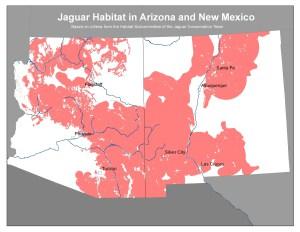by Tony Davis / the Arizona Star Blogging in the Desert
In Saturday’s Star (2-9-2012), I had an article on noted jaguar biologist Alan Rabinowitz’s fierce opposition to the proposed jaguar critical habitat that would span 838,000 acres in Southern Arizona and Southwest New Mexico.
For those who want to dig into the weeds of this dispute, I’m posting here a series of Rabinowitz’s comments to the Fish and Wildlife Service on the proposal, followed by rebuttals from Willcox-area biologist Tony Povilitis.
Povilitis, jaguar insiders will recall, got the ball rolling for federal protection of the jaguar by petitioning back in the 1990s to get it listed as endangered. He not only favors critical habitat and believes this region has good jaguar habitat. He wants it expanded to cover more areas that could serve as movement corridors for the animal. Rabinowitz, by contrast, believes that the Sky Islands and other Southern Arizona natural areas don’t make for good jaguar habitat and that this country doesn’t have any or least not much such habitat.
Here goes:
RABINOWITZ: As a felid biologist and someone who has studied jaguars for decades, I find that this proposed rule to designate critical habitat for the jaguar in the United States is completely unfounded and not supported by available data. The Federal Register document repeatedly states that this proposed rule must be based on the best scientific data available and should be as accurate and effective as possible. But best scientific data and knowledge have not been fully used in this case.
POVILITIS: This review lacks rigorous and objective analysis and does not reflect good conservation policy. With all due respect to Alan Rabinowitz and his jaguar work in Central and South America, I must challenge its statements and assumptions, which could prove harmful to the future of the jaguar and other wide-ranging terrestrial wildlife in the U.S. and northern Mexico.
RABINOWITZ: Not only are substantive data lacking to prove justification for this action, but the assuptions and speculations put forth in this document are, in my opinion, often incorrect and not in the best interests of either the jaguar or the people of the United States. Furthermore, the history of this current action has been controversial, not because of new, relevant data becoming available but due to litigation by NGOs who appear to have their own agenda.
POVILITIS: The NGOs apparently wanted the USFWS to uphold the ESA (Endangered Species Act), a legitimate and worthy agenda. The federal court agreed that USFWS’ decision making was not in accordance with this law, and instructed the agency to carefully reconsider its decision not to do a recovery plan for the jaguar and designate critical habitat.
RABINOWITZ: . . . there are no data from 1962 onward to indicate any breeding or resident population of jaguars within the borders of the United States, as originally stated in the 1972 ruling (placing the jaguar under Endangered Species Act protection south of the Mexican border). Yet there exists more than 30 years of jaguar research data and conservation efforts south of the border, as well as a successful, ongoing program to maintain jaguar populations and genetic continuity through corridors from Mexico through northern Argentina.
Having been one of the original architects of this research, I state now with the utmost confidence that we are doing well to save jaguars throughout this existing range, and that there is no habitat in the United States at this time that is critical to the survival of the jaguar as a species.
POVILITIS: The historical northern peripheral population of the U.S. Southwest and adjacent Mexico is critical to species conservation. . . Recovery programs should pursue range expansion where possible, and not limit efforts to surviving breeding populations in existing, diminished range (which, in this case, occurs in foreign countries beyond USFWS jurisdiction.)
RABINOWITZ: While I am at a loss as to why the USFWS suddenly shifted gears and took this new stand (agreeing in 2010 to designate critical habitat after opposing it before), it appears that political expediency took a back seat to good science.
This reversal came about despite the fact that there were, and remain, NO data indicating that there has been a resident, breeding population of jaguars (or a population of any kind) in the United States since the early 1900s. The jaguar sighting or occupancy data that have been tallied for this proposed action in fact supports the assumption of no resident population in the United States. Most recent sightings have been male jaguars seen once or twice, but never again.
POVILITIS: Jaguars were removed by shooting and other lethal means during most of the past century. Moreover, prey populations were heavily exploited in the early 1900s. Kill records of jaguar, when plotted on 10 year intervals, showed a decline characteristic of an overexploited, resident population. An important part of the ESA is to remedy the loss of species due to overexploitation as well as other factors.
RABINOWITZ: Some of the only substantive data in this report comes from the case of Macho B, a male jaguar camera trapped and followed intermittently for a decade in the SW lands north of the U.S. border. Macho B may have in fact taken residency in the U.S., or he might have still ranged south of the border. In any case, his unusually large ranging area in the U.S., based on camera trap photos, (is) indicative of a jaguar living under subpoptimal conditions in terms of food and reproduction.
POVILITIS: Macho B’s wide-ranging behavior in Arizona may reflect one or both of the following:
1. Jaguar habitat in the immediate borderlands of Arizona, New Mexico and Mexico is characterized by good concentrations of prey and other resources, that are, however, patchily distributed, spatially and temporally.
2. Males that disperse into the U.S. are by nature the widest ranging individuals and have the largest ranges.

